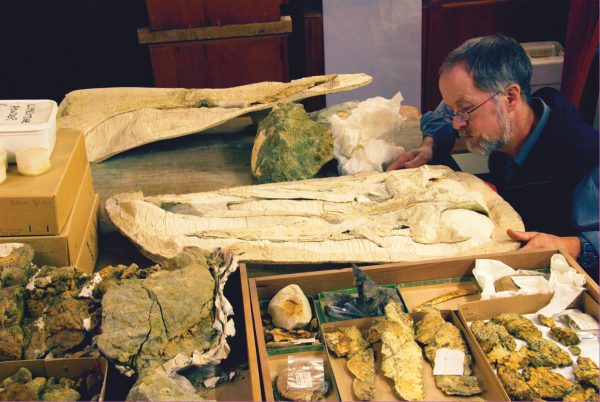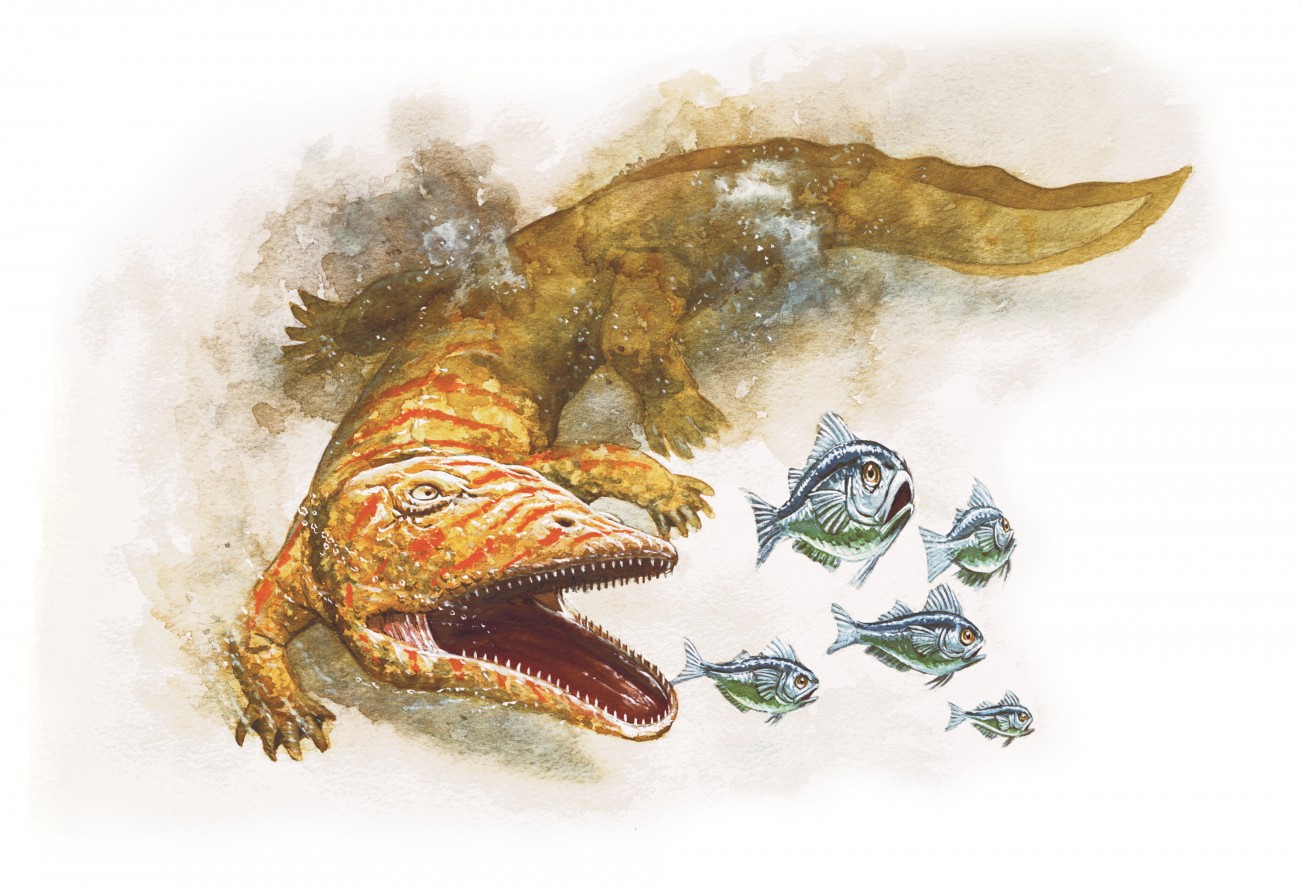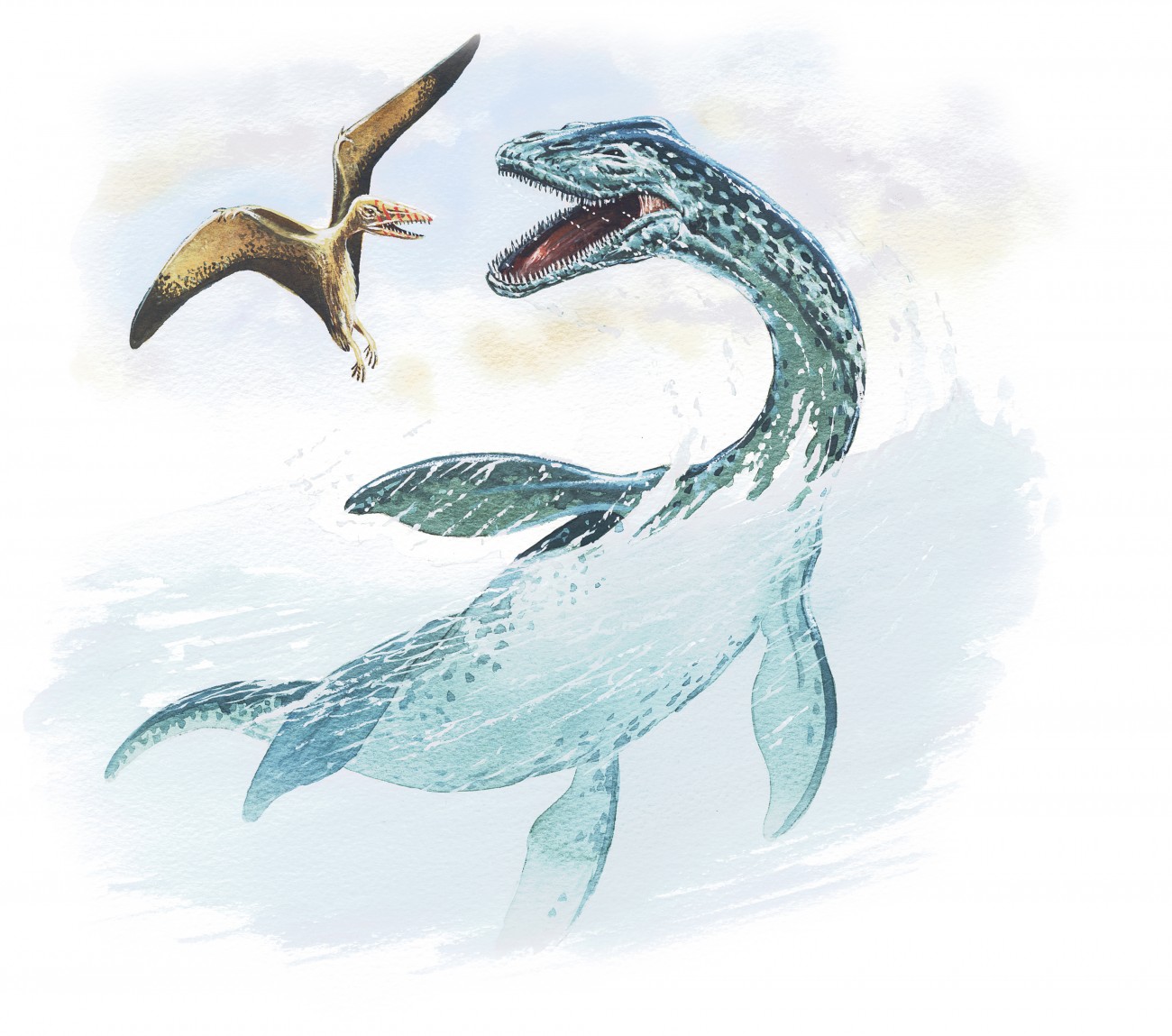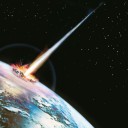
Bones of Contention
In a forest clearing that will one day be the site of the New Zealand Geographic offices, a young megalosaur encounters a family of sauropods.
I like fossils. Perhaps that’s just a reflection of the fact that my kids have called me “Fossil” for the last six or seven years, but I’d like to think it was something more. I’ve periodically gone out of my way to look at fossils in the field, and I’ve purchased a couple of sublime fossil ammonites from Madagascar through eBay, not to mention a mammoth tooth and some teeth from megalodon, a 15 m shark that weighed around 45 tonnes, the biggest shark ever. What do I like about these fossils? It’s that I can actually touch the past, a past that stretches back hundreds of millions of years. They show us how life has developed, the side paths it has followed to dead ends, how the mighty have fallen and the insignificant have persisted.
[Chapter-Break]
We are splashing up a shallow north Canterbury river on an overcast autumn morning. The weather has been dry so it is easy going. I’m accompanying Joy Lines, who lives nearby and has long been interested in local fossils, to an area noted for its marine reptile bones. After a few kilometres, the riverbank on our right becomes a high grey cliff, one into which the wide-swinging river gnaws with every flood. In places, the riverbank and bed become deep mud, derived from slumps of soft grey rock that constitutes the cliff above.
This cliff has an unusual feature. Embedded in it are large spherical balls of much harder rock, called concretions. Some show a thick peeling outer layer, like enormous eyeballs gazing blindly upon us. We come upon some in the river, and Lines is particularly interested in those that have broken open. “You only find the bones inside these concretions,” she explains as she steps around a muddy patch. “Bone usually shows up reddish-brown on the surface.” She hasn’t been fossicking more than a few minutes before she pounces on a large blunt pyramid sticking out of the mud. “Look, that’s bone in there. There, there and there too… and more is exposed on the other sides as well.” She points excitedly. I peer at the rock. There is nothing whitish protruding as I had expected, more a rusty pattern on the surface that doesn’t look like anything in particular.

Up closer, I can see the bone’s coarsely textured cells. It looks much the same as the bits of dinosaur bone from Utah that I have at home. Lines is equipped with a scrubbing brush, but our ice-cream container is not ideal for carrying water to sluice away the mud. So she sets to scrubbing as I ferry water. We won’t be extracting the bones—that’s a job for an expert. All are worn flush with the surface so presumably they are no harder than the rock they are set in, and maybe even softer. And it’s a big rock, a couple of hundred kilos, with its base well-anchored in the mud of the riverbed. Bones are exposed on three faces and more may be further in. Lines points out some sail-shaped bits three centimetres long. “I think those could be teeth.”
These are likely to be the bones of a large marine reptile.
Like the dinosaurs, these marine reptiles prospered during the Mesozoic era (from 251–65 million years ago) and became extinct at the end of it. These were plesiosaurs, mosasaurs, ichthyosaurs and the like, and seem to have been quite common around the coast of what geologists call Zealandia, the piece of Gondwanaland 10 times the size of present-day New Zealand that broke away 83 million years ago and then began to sink.
A movement catches my eye from the middle of the cliff. It’s a long-tailed sheep standing on a concretion sticking out of a near-vertical section of cliff. As I move to get a better view of its seemingly impossible predicament, it spots us and leaps away along the cliff face. Somehow it captures the improbability of the situation. Here we are, in a quiet valley on a cloudy day in rural Canterbury, touching bones that were last alive 70 million years ago.
[Chapter-Break]
Because organisams from warm water differ from cooler-water species, and the composition of fossil floras and faunas alters over time, fossils offer insights into how the climate is changing and maybe even offer some idea of what is causing that change. They also tell us about the environment that the rock holding the fossils was formed in. For instance, deep-water fossils differ from coastal species, and estuarine organisms from those that inhabit rocky shores.
But fossils have another essential use—they can help to date rocks. While it is possible to do this through methods measuring radioactive decay, the process requires sophisticated, non-portable equipment and trained operators and is expensive. Fossils, however, are widespread in sedimentary rocks and many can be easily identified by a trained observer or paleontologist.
Some species and groups are very distinctive, and some flourished only briefly worldwide or in a particular region. These sorts of fossils—often known as index fossils—are useful because they allow geologists to determine the age of rocks with equipment no more elaborate than a hammer and a magnifying glass.
Even when fossils aren’t visible to the naked eye, sedimentary rocks are likely to contain microfossils such as the shells of foraminifera, diatoms and coccolithophores (all minute marine organisms), pollen or spores.
Without fossils, oil exploration would be almost impossible. While drills will pulverise all large fossils, identifiable microfossils can still be seen under a light microscope and used to determine what rock strata the drill is passing through, perhaps 5 km below ground level.

Along with a few key geological events, fossils mark the equivalent of the minutes and hours on the face of the geological clock, or timescale. This timescale is not divided up into eras based on the strict passage of time, but on the disappearance or appearance of species. Geologists divide the past into four major eras—Precambrian, Palaeozoic, Mesozoic and Cenozoic, and each of these is subdivided into many finer divisions such as Period, Epoch, Age, Series and Stage.
Extinctions, or the appearance of major new groups of organisms, generally mark each division, and were caused by large asteroid impacts or widespread volcanism radically altering the climate. The greatest extinction of all time occurred at the end of the Permian, 250 million years ago, and demarcated the Permian from the following Triassic Period. But so major was this event that it also marked the end of the izoic era and the beginning of the Mesozoic. Similarly, a far-reaching extinction marked the end of the Cretaceous Period (and with it the end of the Mesozoic) and the start of the Paleocene in the Cenozoic. This extinction, 65 million years ago, sawact the end of dinosaurs on land and groups such as the ammonites (molluscs similar to today’s chambered nautilus) in the ocean.
New Zealand’s Institute of Geological and Nuclear Sciences at Gracefield, Lower Hutt, maintains a vast fossil collection and a register of all fossil locations in the country. This, the Fossil Record Electronic Database (Fred), and a paper version that is steadily being digitised, contains 88,826 up-to-date records and maps that can be accessed by registered parties. It is the envy of geologists worldwide. The fossil collection, meanwhile, contains 3 million microfossil specimens, 1.2 million macrofossil specimens, 800 vertebrate specimens, millions of specimens of plant microfossils and 10,000 specimens of plant macrofossils.
The invertebrates and microfossils are the most important fossils—because they are widespread and well preserved—but it’s the vertebrate fossils that seize our attention. New Zealand has a small but increasing collection of vertebrates, the great majority of them marine. Although dinosaurs capture public imagination, Otago University paleontologist Ewan Fordyce has noted recently that while the dinosaur remains from the New Zealand region would fit in a shoebox, the bones from large marine reptiles that have been found would require a shipping container.
[Chapter-Break]
The basement of the geology department at Otago University is a “world-class treasure house of marine vertebrate fossils”, says Fordyce proudly, as he leads me down an old staircase and into low rooms congested with plaster casts and bones. I’m scared to touch anything. There is even special lifting apparatus to transfer heavy blocks of rock inside, then up to the next floor of the department, without injury to man or specimen.
On the floor above is the Geology Museum proper, well furnished with a fine collection of fossils. Perhaps unsurprisingly, the shells of molluscs are best represented, and some blocks crammed with shells have had the matrix, or surrounding rock, around the shells partially removed to expose the specimens more effectively. The results are stunning but the work must have been extremely painstaking. In a glass-partitioned room beside the museum, a white-capped and gowned technician, Andrew Grebneff, works carefully to expose a bone by removing surrounding rock under a magnifier using a miniature air tool. The geology department has lent a number of impressive specimens to nearby Otago Museum for its displays on the rocks and fossils of southern New Zealand, and the department’s museum is also open to the public.
Fordyce is particularly interested in whales and dolphins, and he has found some skeletons that are substantially intact. The first whales appeared in the Eocene 53.5 million years ago, from India and Pakistan, and the oldest local fossils are from 40-35 million years ago, at Waihao in South Canterbury. The Waitaki Valley cetaceans are in limestone of late Oligocene age (around 25 million years ago). Thirteen species of fossil whale have been discovered in the area, including ancestors of today’s toothed and baleen whales. Thirty million years ago, Antarctica finally separated from Australia, which allowed the establishment of strong circumpolar currents and is hypothesised to have led to the flourishing of plankton in southern seas and the emergence of the plankton-feeding baleen whales at that time.
[Chapter-Break]
Searching for more of our early vertebrates, Joy Lines and I head to Gore Bay, where she shows me another collection of marine reptile bones exposed in large fragments of what was once a very big concretion. She first found these bones about 15 years ago, all but invisible among the encrusting intertidal organisms. One bone is unmistakably a substantial vertebra some 200 mm high.
Further south are rounded beach stones, which can sometimes contain large fossil crabs. “See those brown marks at either end of this stone?” Lines says, poking a frisbee-sized oval rock under my nose. The marks are the shape of snapped-off pencils, two or three at either end of the rock. “Broken ends of crab legs. This is a beauty. There will be a great crab in here!”

However, our real goal is the place where Lines has discovered several articulated whale vertebrae. The area is difficult to get to because the blocks of rock crowding the shoreline are the size of trucks. The one in which we find the whale vertebrae is peculiar. It looks as if it has formed on an exposed rocky beach, where everything was tumbled by the surf, with rounded pebbles packed tightly together, worn shells and fragments of a bivalve.
The whale vertebrae are quite different from the reptile bones we saw up the river. Although they are a similar rusty colour, they are sticking out of the rock, and stubs of ribs are attached to them. Each vertebra is the size of a large paint tin.
Nearby we photograph a couple of other smaller bones. Everything here looks much younger than at the marine reptile localities.
After Lines injures her knee trying to clamber under another huge boulder, we return back along the coast, with fossils on our minds. Without them we would never know that dinosaurs, ammonites, woolly mammoths and legions more creatures ever existed. Indeed, almost all the organisms that have ever lived on Earth are now extinct. Fossils are not merely elderly curiosities, they are relics of the history of life on Earth.





















